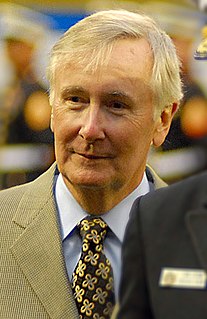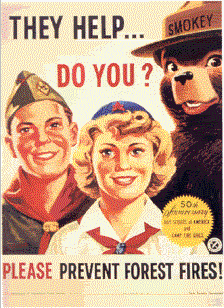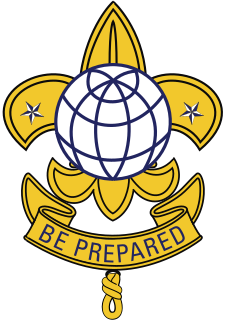
Norman Percevel Rockwell was an American painter and illustrator. His works have a broad popular appeal in the United States for their reflection of the country's culture. Rockwell is most famous for the cover illustrations of everyday life he created for The Saturday Evening Post magazine over nearly five decades. Among the best-known of Rockwell's works are the Willie Gillis series, Rosie the Riveter, The Problem We All Live With, Saying Grace, and the Four Freedoms series. He is also noted for his 64-year relationship with the Boy Scouts of America (BSA), during which he produced covers for their publication Boys' Life, calendars, and other illustrations. These works include popular images that reflect the Scout Oath and Scout Law such as The Scoutmaster, A Scout Is Reverent and A Guiding Hand, among many others.

The Boy Scouts of America is one of the largest scouting organizations and one of the largest youth organizations in the United States, with about 1.2 million youth participants. The BSA was founded in 1910, and since then, about 110 million Americans have participated in BSA programs. BSA is part of the international Scout Movement and became a founding member organization of the World Organization of the Scout Movement in 1922.

Scouting in Kentucky has a long history, from the 1910s to the present day, serving thousands of youth in programs that suit the environment in which they live. Kentucky has a very early Scouting heritage, as the home state of Daniel Carter Beard.

Scouting in Vermont has a long history, from the 1907 to the present day, serving thousands of youth in programs that suit the environment in which they live.

The Boy Scouts of the Philippines (BSP) is the national scouting organization of the Philippines in the World Organization of the Scout Movement. The Scout movement was first introduced in the Philippines on 1910 during the American Occupation. It was "granted Recognition as a Member Organisation of the Boy Scouts International Conference...with effect from October 31, 1936" by virtue of certification signed by J. S. Wilson, Olave Baden-Powell, and Daniel Spry.

Howard Charles Lincoln is an American lawyer and businessman, known primarily for being the former Chairman of Nintendo of America and the former Chairman and Chief Executive Officer of the Seattle Mariners baseball team, representing absentee majority owner Hiroshi Yamauchi until Yamauchi died on September 19, 2013.

The National Scout jamboree is a gathering, or jamboree, of thousands of members of the Boy Scouts of America, usually held every four years and organized by the National Council of the Boy Scouts of America. Referred to as "the Jamboree", "Jambo", or NSJ, Scouts from all over the nation and world have the opportunity to attend. They are considered to be one of several unique experiences that the Boy Scouts of America offers. The first jamboree was scheduled to be held in 1935 in Washington, D.C. to celebrate the 25th anniversary of Scouting, but was delayed two years after being cancelled due to a polio outbreak. The 1937 jamboree in Washington attracted 25,000 Scouts, who camped around the Washington Monument and Tidal Basin. The event was covered extensively by national media and attended by President Franklin D. Roosevelt.

Pierre Joubert was a French illustrator and comics artist. He was closely associated with the creation of Scouting and the popular look of Boy Scouts in France and Belgium, comparable to the American artist Norman Rockwell.

Yawgoog Scout Reservation is a 1,800-acre (7 km2) reservation for scouting located in Rockville, Rhode Island and operated by the Narragansett Council of the Boy Scouts of America. Founded in 1916, Yawgoog is the fifth oldest Boy Scout camp in the United States. At the camp is run an eight-week camping program every summer where Boy Scouts stay for a week with their troops. The reservation is divided into three camps: Three Point, Medicine Bow, and Sandy Beach.

Good Scouts is a 1938 American animated short film produced by Walt Disney Productions and released by RKO Radio Pictures. The cartoon follows Donald Duck leading his nephews Huey, Dewey, and Louie on a scouting trip through the wilderness. It was directed by Jack King and features Clarence Nash as Donald and the three nephews.

William Hillcourt, known within the Scouting movement as "Green Bar Bill", was an influential leader in the Boy Scouts of America (BSA) organization from 1927 to 1992. Hillcourt was a prolific writer and teacher in the areas of woodcraft, troop and patrol structure, and training; his written works include three editions of the BSA's official Boy Scout Handbook, with over 12.6 million copies printed, other Scouting-related books and numerous magazine articles. Hillcourt developed and promoted the American adaptation of the Wood Badge adult Scout leader training program.

James Edward West was a lawyer and an advocate of children's rights, who became the first professional Executive Secretary, soon renamed Chief Scout Executive, of the Boy Scouts of America (BSA), serving from 1911 to 1943. Upon his retirement from the BSA, West was given the title of Chief Scout.
Joseph Csatari is a realist artist who worked with Norman Rockwell. As a boy, Csatari had painstakingly recreated Saturday Evening Post covers that Rockwell had painted. In 1977, shortly before Rockwell died, Csatari was commissioned as the Boy Scouts of America (BSA)'s official artist.

Scouts BSA is the flagship membership level of the Boy Scouts of America (BSA) for boys and girls between the ages of typically 11 and 17. It provides youth training in character, citizenship, and mental and personal fitness. Scouts are expected to develop personal religious values, learn the principles of American heritage and government, and acquire skills to become successful adults.

Since Scouting began in 1907, it has entered into many elements of popular culture, including movies, TV and books.
Brown & Bigelow is a company based in Saint Paul, Minnesota, that sells branded apparel and promotional merchandise.

International Boy Scouts, Troop 1, Japan's first Boy Scout troop, was founded in 1911 with Clarence Griffin as Scoutmaster. Despite its early multinational character the troop's original registration was with the London headquarters of The Boy Scouts Association as "British Scouts in Foreign Countries". This initial charter was due to there being no international Boy Scout office and the "nationality requirement" that was in effect at the time. In 1918 the troop's character changed considerably when the new Scoutmaster, Bro. Joseph Janning, received approval from Lord Baden-Powell to officially reorganized the troop as a mixed-nationality, or "international", troop. B-P subsequently brought the Troop's situation before the 3rd World Scout Conference where the newly formed Boy Scouts International Bureau received approval to directly register Troop 1 and, in the future, other such "international" groups. The troop was then directly registered by the Boy Scouts International Bureau and was issued the Boy Scout movement's first "mixed nationality" charter, dated October 30, 1925, signed by Baden-Powell as Chief Scout and Hubert S. Martin as Director of the new International Bureau. Within a few years the nationality requirement was abolished and, even though the Bureau maintained the direct registration of Troop 1 and other groups already registered, new groups were requested to join the national organization of the country in which they were located and no new groups were chartered. Over the years the directly chartered groups one-by-one and for varied reasons slowly disbanded and by 1955 only Troop 1 remained. The troop has been continuously active, including war years, since its first meeting held in Yokohama, Japan on October 16, 1911, and currently consists of coed sections of Beaver Scouts, Cub Scouts, Scouts, Senior Scouts, and Veteran Scouts.

Growth of a Leader is a 1964 painting by Norman Rockwell. It appeared as the 1966 Brown & Bigelow Boy Scout Calendar. Long-time Rockwell model James Edgerton and his son are depicted as a Scout moving through the stages of a man's Scouting career.

We, Too, Have a Job to Do is a painting by American illustrator Norman Rockwell that depicts a Boy Scout in full uniform standing in front of a waving American flag. It was originally created by Rockwell in 1942 for the 1944 Brown & Bigelow Boy Scout Calendar. The model, Bob Hamilton, won a contest to be in the painting and personally delivered a print to the Vice President of the United States at the time, Henry A. Wallace.

















